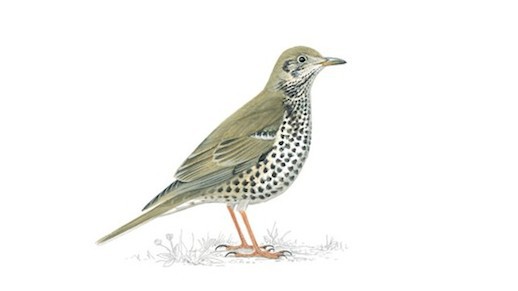By Richard Hines.
‘The upper parts are grey-brown and the breast nearly white, spotted with dark brown’.
The Observer’s Book of Birds, 1952
‘Birds that sing for a short time, and very early in spring:
Missel- bird … in February.’
Selborne, Nov.2, 1769. Letter, Gilbert White.
Perched high at the top of a tree in early spring singing its lonely song, the mistle thrush, gave me the impression it was an aloof bird, unreachably wild. Then one August evening as I sat in the garden I heard its song floating out of the open windows of the house. Tiptoeing inside I saw the mistle thrush, perched on top of the open sitting room door, its loud melancholy song filling the house.
Next day I spotted the mistle thrush pecking at the crust of an apple pie cooling on a worktop after it had flown in through the open kitchen door. After that each time I raised my arm it flew down from a tree to perch on my hand and feed. I’d always known mistle thrushes were daring. I’d seen one dive bomb a boy as it tried to deter him from climbing up to its nest in the fork of a tree. And my guess was that this bold nature and hunger – it would have had difficulty finding food in the hard ground of that hot summer – explained why the mistle thrush was so remarkably tame. What I couldn’t attempt to explain was that I’d heard the mistle thrush sing in August. According to books about birds stretching back to Gilbert White’s 18th century Natural History of Selborne, mistle thrushes only sang in early spring. I contacted Tim Birkhead, ornithologist and professor of animal behaviour. Tim was puzzled and searched through old books written by men who’d kept mistle thrushes as songbirds. In 1887, R. L. Wallace wrote they become ‘very tame if hand reared’. In 1802, George Montagu noted that a male mistle thrush becomes silent after singing in spring, but a hand reared female ‘continues its song the whole summer.’
It seems the mistle thrush was a hand reared female. And that when I stood within touching distance of her as she perched on the sitting room door singing, I’d become one of a privileged few who over the centuries had listened to that beautiful song in late summer.
No way but Gentlenesse, by Richard Hines, a memoir to be published by Bloomsbury in January 2016.
As a teenager Richard read T.H. White’s book The Goshawk. Enthralled he sought out a falconry manual in the library. He felt like a scholar who had come across an ancient manuscript. Words from a long lost age came to life: lure, jesses, imping needle. And he loved the quote from a book written by Edmund Bert in 1619: ‘There is no way but gentlenesse to redeeme hawke’. He used the instructions from the hawking manual to train his kestrel Kes, which had been taken from a nest in a ruined Hall, and which he kept in a Second World War air raid shelter in his older brother Barry’s garden. It was watching Richard train his kestrel which gave Barry the idea to write his Penguin Classics novel, A Kestrel for a Knave, which was filmed as Kes.
